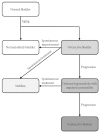Underactive Bladder; Review of Progress and Impact From the International CURE-UAB Initiative
- PMID: 32252181
- PMCID: PMC7136442
- DOI: 10.5213/inj.2040010.005
Underactive Bladder; Review of Progress and Impact From the International CURE-UAB Initiative
Abstract
There is a significant need for research and understanding of underactive bladder (UAB). The International Congress of Urologic Research and Education on Aging UnderActive Bladder (CURE-UAB) was organized by Doctors Michael Chancellor and Ananias Diokno in order to address these concerns. CURE-UAB was supported, in part, by the US National Institute of Aging and National Institute of Diabetes Digestive and Kidney. Since 2014, there have been 5 successful CURE-UAB congresses. They have brought together diverse stakeholders in the UAB field to identify areas of major scientific challenge and initiated a call to action among the medical community. In this review, we will highlight current and novel treatments under development for UAB and the progress and impact from the CURE-UAB initiative.
Keywords: Aging; Overactive urinary bladder; Sarcopenia; Underactive urinary bladder; Urodynamics.
Conflict of interest statement
Michael B Chancellor is one of the inventors of the autologous muscle-derived cell process and has received royalty payments for the stem cell process and payments for consulting from Cook MyoSite. Except for that, no potential conflict of interest relevant to this article was reported.
Figures



References
-
- van Koeveringe GA, Vahabi B, Andersson KE, Kirschner-Herrmans R, Oelke M. Detrusor underactivity: a plea for new approaches to a common bladder dysfunction. Neurourol Urodyn. 2011;30:723–8. - PubMed
-
- Osman NI, Chapple CR, Abrams P, Dmochowski R, Haab F, Nitti V, et al. Detrusor underactivity and the underactive bladder: a new clinical entity? A review of current terminology, definitions, epidemiology, aetiology, and diagnosis. Eur Urol. 2014;65:389–98. - PubMed
-
- Chancellor MB, Diokno AC. The underactive bladder. Cham (Switzerland): Springer International Publishing; 2016.
-
- Chancellor MB, Bartolone SN, DeVries EM, Diokno AC, Gibbons M, Jankowski R, et al. New technology assessment and current and upcoming therapies for underactive bladder. Neurourol Urodyn. 2018;37:2932–7. - PubMed
-
- Dewulf K, Abraham N, Lamb LE, Griebling TL, Yoshimura N, Tyagi P, et al. Addressing challenges in underactive bladder: recommendations and insights from the Congress on Underactive Bladder (CURE-UAB) Int Urol Nephrol. 2017;49:777–85. - PubMed
Grants and funding
LinkOut - more resources
Full Text Sources
Miscellaneous

